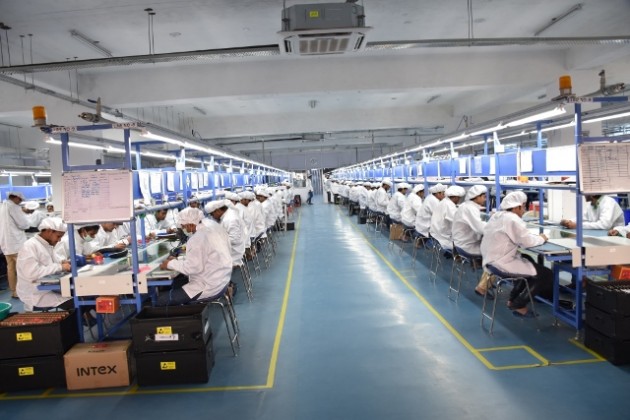Nidhi Markanday, director at Intex Technologies, has revealed how some of the latest guidelines in India are encouraging phone companies to step up manufacturing in the country.

Intex, one of the leading device companies in India, is setting up a new manufacturing facility in Kasna, Greater Noida (Uttar Pradesh) as part of its strategy to consolidate all the Noida manufacturing capacity at a single location. The Kasna manufacturing unit will have mobile production capacity of 40 million per annum against the current capacity of 2 million per month.
The expansion plans of Intex reflect the consumer demand in India. India’s mobile subscriber base of over 1.05 billion creates enormous opportunities for handset manufacturing companies in India. The Indian electronics industry is anticipated to reach $400 billion in 2022 with projected growth of compound annual growth rate (CAGR) of 24.4 percent during 2012-2020.
Government policies
This growth is being encouraged both by government policies, incentives and international investment. With the rapid integration of the notions of “Make in India” into the Indian economy by the Government, more and more organizations are opting for domestic manufacturing. India is working towards becoming a manufacturing hub by the year 2020.
The Union Budget 2018 supported the Indian manufacturing policy of several phone makers. The hike in customs duty on mobile phones from 15 percent to 20 percent, on some of their parts and accessories to 15 percent and on certain parts of televisions to 15 percent will encourage phone companies to produce more products locally.
“This is enabling organizations to move to domestic manufacturing to save on costs, making India into a manufacturing hub. For Indian companies, this has come as a blessing. Major market players in the mobile industry which are homegrown brands, welcomed the ideology, supporting domestic device manufacturing,” Nidhi Markanday said.
On the other hand, international brands which are currently operating in India are at a loss. With the tariffs on the rise for devices and their components, importing just got a whole lot expensive for such brands. They are working towards investing in the Indian mobile ecosystem and moving towards domestic manufacturing. This, in turn, will support the expansion of manufacturing capacity in India.
Rajeev Nair, senior analyst – Smart Connected Devices, Strategy Analytics, said: “Our estimates confirm to handset manufacturing having more than quadrupled globally, over the past two decade. Asia Pacific being the biggest region currently, for handset production. China continues to lead as a manufacturing destination, with nearly 3 in 4 phones globally getting made there. However surging labour cost is a worry.”
The manufacturing landscape in India currently holds various benefits. Organizations will have an easy access to skilled and unskilled labor and highly qualified managers and executives. There are also various hubs which hold some of the largest manufacturing plants in the country. Availability of the same, along with comparatively economical raw materials and components, with policies supporting domestic manufacturing, makes India an ideal country to invest into.
“Next wave of device manufacturing would be driven by 5G. The possibilities with 5G would not be just limited to smart phones, but would open up avenues for interesting applications in the areas of augmented reality, artificial intelligence, ultra-high speed internet enabled devices etc. This would drive device manufacturing to the next level with volumes ramping up to quantities not seen until now,” said Sandeep Kapoor, head Marketing Aerospace Defense – EMEAI Region & country head Marketing India.
Challenges in device manufacturing
Intex believes that the benefits of domestic manufacturing do come with challenges. Transportation and logistics is one such expanse. Due to the availability of subpar transportation facilities as compared to global standards, the manufacturing and distribution processes will take much longer. Power supply is yet another challenge.
Nidhi Markanday believes that though metropolitan cities are well connected with an availability of constant power back up, the rural areas are still lagging. The government is working towards creating initiatives to build a better connected and powered country, but that will take time.
“India still needs to do more to increase its share of nearly 10 percent in 2017 of the global manufacturing output. Some of the other key countries into handset manufacturing include South Korea and Brazil etc.,” Rajeev Nair said.
The PMP notification gives a clear road map to local manufacturers as to how the Government intends to support increased local value addition with proper fiscal and financial incentives. It will enable each Company to plan its indigenization program with the help of local and overseas vendors.
For the country, it is a commitment given by the Government that they would like to develop India into a competitive manufacturing hub for mobile phones, leading to creation of several thousands of new jobs, saving in foreign exchange and increased exports.
The Phase 1 of PMP, kicked off in 2015, has encouraged local mobile assembly APTP (Assembly, Programming, Test and Packaging) and has led to creation of direct jobs estimated to be around 30,000 with an investment of about Rs 250 crore.
Further in the Second phase, the policy has encouraged in moving up the value chain by localization of mobile accessories viz. Charger, Earphone, Data Cable, Mobile batteries. This has resulted in another direct job creation of approximately 15K workmen and investment of around Rs 200 crore.
The next step in PMP is critical as it needs developments in areas such as Mobile Design and IDH that would primarily drive the ecosystem for Fabrication, PCB design etc.
Indian phone manufacturing companies are gearing up for more opportunities thanks to Digital India vision and related programs. The India Government is determined to achieve its target of increasing the contribution of manufacturing output to 25 percent of Gross Domestic Product by 2025, from 16 percent currently.
Baburajan K





